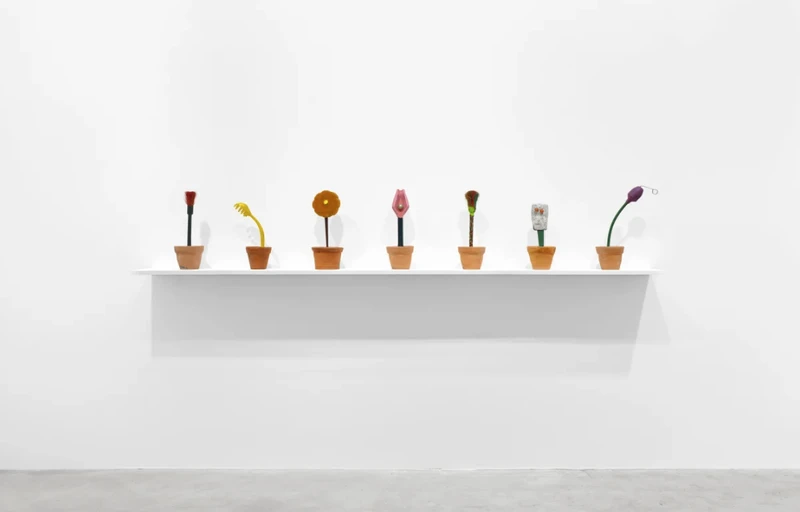Feliciano Centurión: Hope in Bloom
6 Nov-13 Dec 2024
PV 6 Nov 2024, 6-8pm


Feliciano Centurión (b. 1962, Paraguay, d. 1996, Argentina) was part of a pivotal moment in Latin American consciousness, when artists took a turn towards subjectivity, warmth and lightness in the aftermath of a politically turbulent age. The body of work Centurión left behind from his brief career is intimately handmade, attentive to emotion and unashamedly optimistic. Frequently embroidered with aphorisms of love and hope and ornamented with starbursts and blooming flowers, it is invigorated by its political defiance of gender roles and queering of the Paraguayan textile traditions taught by his mother and grandmother, forming one of the most poignant testimonies left by an artist working through the AIDs crisis and an era that redefined homosexuality.
Hope in Bloom is Centurión’s second solo exhibition at Cecilia Brunson Projects, who introduced his work to the UK in 2019. Since then, in alignment with the institutional re-evaluation of textile art in recent years, he has received global recognition, with multiple solo exhibitions in New York and inclusion in seminal exhibitions such as Unravel, currently on display at the Stedelijk Museum, Amsterdam. Despite a prevalent narrative focus on the artist’s final years and the works produced under the shadow of his HIV diagnosis in 1992, Centurión’s consistent intention was to produce beauty and to articulate the transience and mutability of our corporeal world with optimism and joy. This is reflected in Hope in Bloom, showcasing works from Centurión’s estate which have not been exhibited since his death, including his rarely seen sculptural Macetas [Flowerpots].
Each Maceta consists of a terracotta flowerpot filled with plaster, from which a single stem, crafted from household objects including brushes, sponges and kitchen utensils, rises proudly like a flower. The artist is known for his textiles, but these core works are exemplary of his pursuit to produce artworks unburdened and light, marked by humour and beaming with life.
Centurión repeatedly returned to the anodyne symbol of the flower, exploiting the great scope of meaning in its short-lived beauty. He reveals the power in the simplest everyday objects: here, the flowerpots unlock something about the comfort of home, the pleasure in taking root and making beauty in that home. This is a notion that recurs throughout the work of Centurión, who was uprooted in his childhood when his family were exiled to Argentina during the dictatorship of Alfredo Stroessner, and whose adulthood was split between the cities of Asunción and Buenos Aires.
This is also exemplified in the Frazadas [Blankets] exhibited. Centurión frequently worked with the synthetic blankets used for household packing and for shelter by the homeless, cutting and reframing these materials with satin trims. Adorning the works with his painting, ñandutí (a Paraguayan lace), artificial flowers encircled with the lines of a poem, or coasters found in a second-hand shop, he draws upon the poetic values of textiles – sewing as a means of repair, blankets as objects of comfort – and once more extracts deep meaning from objects so commonplace.
Speaking about the Frazadas in an undated manifesto, Centurión wrote ‘it is essential that we “choose” the materials with which we work. Our consumer society offers us an infinite selection that we can “appropriate” to make “new objects” with which we can live. But once we decontextualise them, assemble them, paint them, or assail them, they reveal that they passed through our feelings.’
The largest work on display, Flores Negras [Black Flowers], 1992, was produced in the year of Centurión’s HIV diagnosis. At over two metres tall, it is one of the last large-scale works he made, representing a fulcrum between his bright, early works and the delicate embroideries that followed throughout his illness. In the thorned, twisting stems and fragile ñandutí petals, he speaks once more of the flower’s allure, rooted in its own ephemerality.
About the artist:
Feliciano Centurión was born in San Ignacio de las Misiones, Paraguay, an environment defined by the coexistence of indigenous Guarani and Catholic cultures, and lastingly affected by the devastation of the Triple Alliance War, in which 90% of the male population were killed. Centurión was raised by his mother and grandmother, from whom he learnt the crafts of sewing, crochet and ñanduti. Under the dictatorship of Alfredo Stroessner, Centurión and his family were forced into exile to Argentina in 1973. Centurión received his formal art education in Argentina and participated in numerous solo and group exhibitions, both in Asuncion, Paraguay, and in Buenos Aires, Argentina, as part of the group of artists linked to the Gallery of the Cultural Centre Ricardo Rojas. He participated in the Fifth Biennial of Cuba (1992), and travelled to exhibit at the Maison de L’Amerique Latine in France. He died in Buenos Aires, Argentina, on November 7, 1996.
A renewed celebration of his work in recent years has led to solo exhibitions at the Americas Society, New York (2020) and at New York University’s Institute of Fine Arts (2023). Recent group exhibitions include Unravel: The Power and Politics of Textiles in Art, Barbican, London and Stedelijk Museum, Amsterdam (2024-5), Threads to the South, ISLAA, New York (2024), Every Moment Counts—AIDS and its Feelings, Henie Onstad Kunstsenter, Oslo (2022) and the 13th Shanghai Biennale (2021). Cecilia Brunson Projects has represented the artist’s estate since 2018 and works closely with Feliciano’s family.
Feliciano Centurión: Hope in Bloom press release
Download